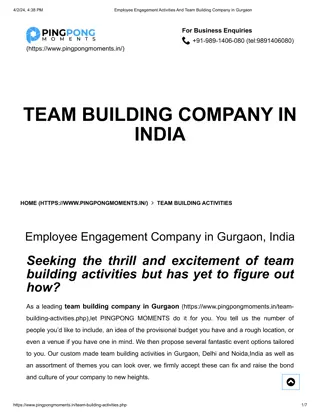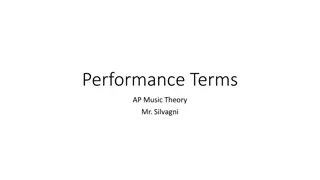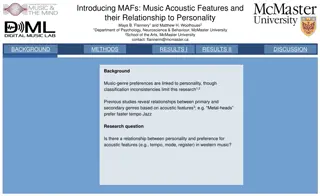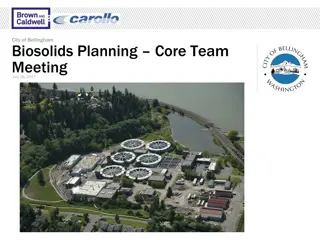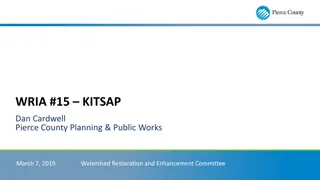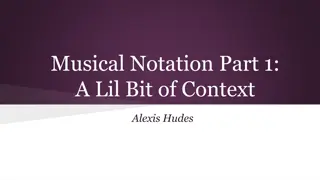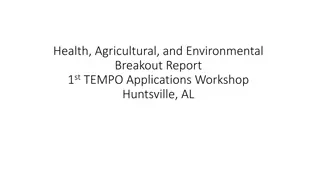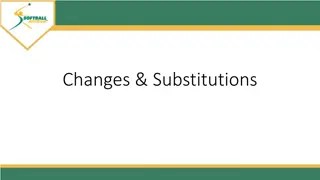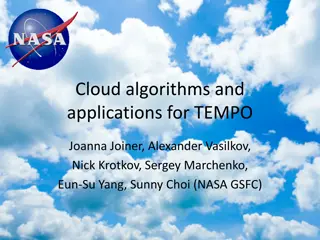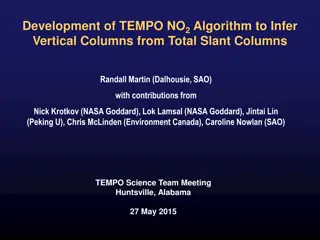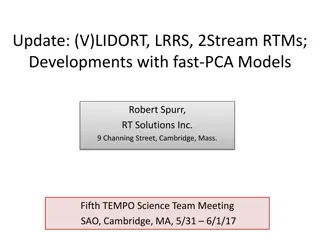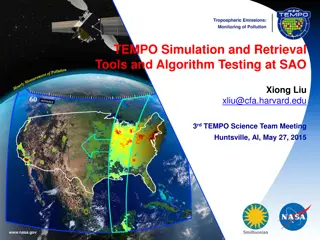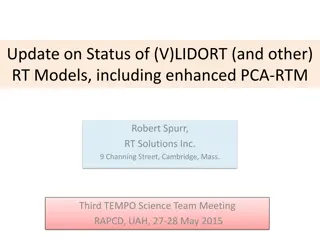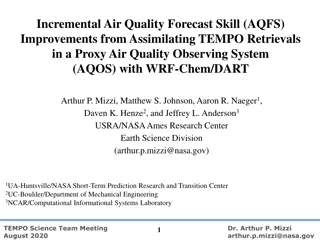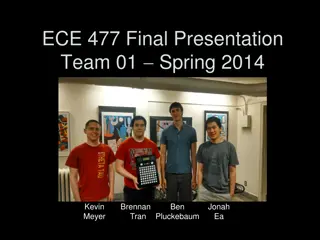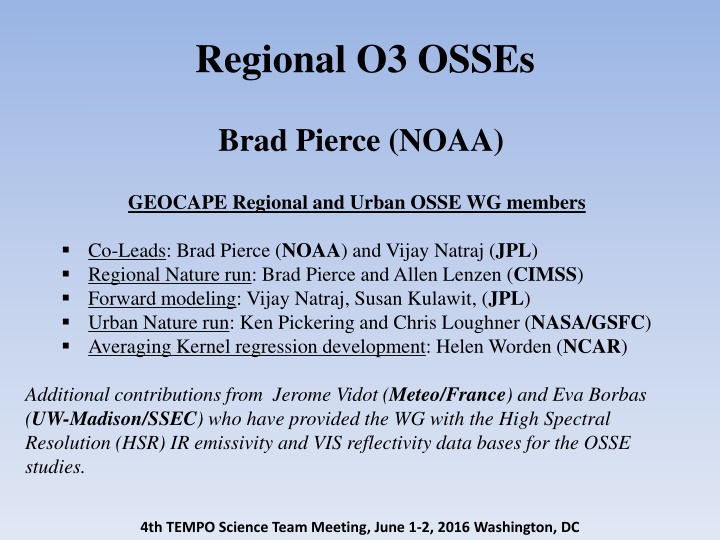
Understanding Regional Ozone OSSE Studies and Goals
Explore the collaborative efforts and goals of the Regional Ozone OSSE team, including nature runs, forward modeling, urban simulations, and synthesis of realistic atmospheric data. Discover correlations, biases, and insights from the OSSE experiments conducted to enhance atmospheric understanding and modeling accuracy.
Download Presentation

Please find below an Image/Link to download the presentation.
The content on the website is provided AS IS for your information and personal use only. It may not be sold, licensed, or shared on other websites without obtaining consent from the author. If you encounter any issues during the download, it is possible that the publisher has removed the file from their server.
You are allowed to download the files provided on this website for personal or commercial use, subject to the condition that they are used lawfully. All files are the property of their respective owners.
The content on the website is provided AS IS for your information and personal use only. It may not be sold, licensed, or shared on other websites without obtaining consent from the author.
E N D
Presentation Transcript
Regional O3 OSSEs Brad Pierce (NOAA) GEOCAPE Regional and Urban OSSE WG members Co-Leads: Brad Pierce (NOAA) and Vijay Natraj (JPL) Regional Nature run: Brad Pierce and Allen Lenzen (CIMSS) Forward modeling: Vijay Natraj, Susan Kulawit, (JPL) Urban Nature run: Ken Pickering and Chris Loughner (NASA/GSFC) Averaging Kernel regression development: Helen Worden (NCAR) Additional contributions from Jerome Vidot (Meteo/France) and Eva Borbas (UW-Madison/SSEC) who have provided the WG with the High Spectral Resolution (HSR) IR emissivity and VIS reflectivity data bases for the OSSE studies. 4th TEMPO Science Team Meeting, June 1-2, 2016 Washington, DC
GEOCAPE O3 OSSE Goals July 2011 DISCOVER-AQ Period Utilize independent modeling systems for generation of Nature atmosphere and conducting assimilation impact experiments Account for realistic atmospheric variability, which requires evaluation of the nature runs with respect to observations Include realistic variability in the synthetic radiances, which requires using realistic albedos and emissivities Include realistic sensitivities, which requires generation of averaging kernels (AK) for each retrieval for use in assimilation studies
Nature/Retrieval Correlations Regional Multiple Regression AK Retrievals (UV, UV-VIS, UV-VIS-TIR) 18km All correlations troposphere/lower stratosphere retrievals show high upper (>0.9) in 12km UV-VIS-TIR shows the highest correlations (>0.8) in the mid and lower troposphere 6km 3km 1km UV-VIS shows improvement over the UV only retrievals below 800mb
Nature/Retrieval Biases Regional Multiple Regression AK Retrievals (UV, UV-VIS, UV-VIS-TIR) Generally low biases (<20%) except: 18km between 200-400mb at sunrise and sunset (UV and UV-VIS only) 12km Below 900mb (underestimate daytime and overestimate nighttime O3) 6km 3km 1km
July 2011 WRF-CHEM/GSI OSSE Experiments Synthetic OMI (using actual retrieval efficiency factors and apriori) OMI+ Multiple Regression GEOCAPE UV-VIS-TIR synthetic retrievals OMI+ Multiple Regression GEOCAPE UV-VIS synthetic retrievals OMI+ Multiple Regression GEOCAPE UV synthetic retrievals Multiple Regression GEOCAPE UV-VIS-TIR synthetic retrievals Multiple Regression GEOCAPE UV-VIS synthetic retrievals Multiple Regression GEOCAPE UV synthetic retrievals All OSSE experiments include: 1 hour cycling Inflation of background error covariances near surface Application of linear observation operator (AK) in GSI enter loop needed for stability during initial large UTLS adjustments Results compared to nature run integrated over atmospheric layers (12-18km, 6-12km, 0-6km, 0-3km, 0-1km)
Diurnal Averaged Bias OMI+MR OSSE results Significant reductions in high biases introduced by OMI for all MR retrievals except the surface-1km and surface-3km layers 12-18km 6-12km OMI+MR UV and OMI+MR UVVIS show similar results OMI+UVVISTIR shows lower biases between 12- 18km but larger biases then UV or UVVIS below 12km sfc-6km sfc-3km sfc-1km
Diurnal Averaged Bias MR OSSE results Significant reductions in high biases introduced by OMI for all MR retrievals except the surface-1km and surface-3km layers 12-18km 6-12km OMI+MR UV and OMI+MR UVVIS show similar results OMI+UVVISTIR shows lower biases between 12- 18km but larger biases then UV or UVVIS below 12km sfc-6km sfc-3km sfc-1km
Diurnal Averaged RMS Error MR OSSE results Slight improvements in RMS error over OMI for all MR retrievals except the surface-1km layer OMI+MR UV and OMI+MR UVVIS show similar results 12-18km 6-12km OMI+UVVISTIR shows largest improvements sfc-6km sfc-3km sfc-1km
Diurnal Averaged RMS Error OMI+MR OSSE results Slight improvements in RMS error over OMI only for all MR retrievals OMI+MR UV and OMI+MR UVVIS show similar results 12-18km 6-12km OMI+UVVISTIR shows largest improvements sfc-6km sfc-3km sfc-1km
Diurnal Averaged Correlation OMI+MR OSSE results Slight improvements in correlation over OMI only for all MR retrievals 12-18km OMI+MR UV and OMI+MR UVVIS show similar results OMI+UVVISTIR shows largest improvements 6-12km sfc-6km sfc-3km sfc-1km
Diurnal Averaged Correlation MR OSSE results Slight improvements in correlation over OMI for all MR retrievals 12-18km MR UV and UVVIS retrievals show similar results 6-12km OMI+UVVISTIR shows largest improvements sfc-6km sfc-3km sfc-1km
Summary Hourly geostationary UV, UVVIS, and UVVISTIR ozone retrievals show high correlations with nature run (>0.8) except for sunrise/sunset UV and UVVIS retrievals and below 700mb (3km) Hourly geostationary UV, UVVIS, and UVVISTIR ozone retrievals show fairly low biases relative to nature run (<20%) except for sunrise/sunset UV and UVVIS retrievals and below 900mb (1km) Assimilation of hourly geostationary UV, UVVIS and UVVISTIR ozone retrievals improves correlation, rms error and bias relative to control and OMI polar orbit retrievals in the upper troposphere lower stratosphere (12-18km), middle troposphere (6-12km) and lower troposphere (0-6km) Surface-1km and surface-3km layers show neutral results for correlation and rms errors and slight increases in diurnally averaged biases when hourly geostationary UV, UVVIS, and UVVISTIR ozone retrievals are assimilated. These WRF-CHEM/GSI results suggest that it will be difficult to obtain improvements in boundary layer ozone analyses through 3D variational assimilation of geostationary ozone retrievals alone due to the strong dependence on ozone precursor emissions.


